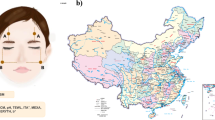Abstract
Nasal skin quality is an essential indicator of rhinoplasty outcomes. The objective of this study was to collect data on the nasal skin thickness of randomly selected Turkish men and women. The study involved 50 male and 50 female subjects. We measured the nasal dorsal skin thickness by pinching the sides of the nose upwards to produce a skinfold and then measuring the thickness of this skinfold with a Castroviejo caliper [A&A, Almecon Instruments]. We also measured the thickness of the right and left alar walls with the same caliper. In the male subjects, the mean nasal dorsal thickness and the mean overall, right, and left alar wall thicknesses were 4.02 ± 0.71, 3.99 ± 0.69, 3.98 ± 0.69, and 4.00 ± 0.69 mm, respectively. The corresponding values in the female subjects were 3.38 ± 0.56, 3.45 ± 0.66, 3.43 ± 0.67, and 3.46 ± 0.65 mm. In Turkish men, a nasal dorsum measuring greater than 4 mm can be considered “thick.” In Turkish women, the mean nasal dorsal and alar wall thicknesses were 3.38 and 3.45 mm, respectively. Values greater than these are considered “thick.” Either nasal dorsal thickness or alar wall thickness may be measured in men, but both must be measured in women scheduled to undergo rhinoplasty. Dark nasal skin and oily nasal skin tend to be thicker.



Similar content being viewed by others
References
Tardy ME Jr, Thomas R (2010) Rhinoplasty. In: Flint PW, Haughey BH, Harker LA, Schuller DE, Richardson MA, Robbins KT, Thomas JR (eds) Cummings Otolaryngology, 4th edn. Mosby, New York, pp 1028–1031
Karaaltin MV, Orhan KS, Demirel T (2009) Fascia lata graft for nasal dorsal contouring in rhinoplasty. J Plast Reconstr Aesthet Surg 62:1255–1260
Jang YJ, Wang JH, Sinha V, Song HM, Lee BJ (2007) Tutoplast-processed fascia lata for dorsal augmentation in rhinoplasty. Otolaryngol Head Neck Surg 137(1):88–92
Fanous N, Brousseau VJ, Karsan N, Fanous A (2008) Predicting the results of rhinoplasty before surgery: Easy noses versus difficult noses. Can J Plast Surg 16(2):69–75
Rahman M, Jefferson N, Stewart DA et al (2010) The histology of facial aesthetic subunits: implications for common nasal reconstructive procedures. J Plast Reconstr Aesthet Surg 63:753–756
Powell N, Humphreys B (1984) Proportions of the Aesthetic Face. Theme-Stratton, New York, pp 21–32
Cochran CS, Marin VP (2007) Cosmetic Surgery: A systematic approach to open rhinoplasty. Oper Techn Otolaryngol Head Neck Surg 18:166–171
Klinger M, Caviggioli F, Forcellini D et al (2012) Primary nasal tip surgery: a conservative approach. Aesthetic Plast Surg 36(3):485–490
Farrior EH, Ballert JA (2012) Nuances of the nasal tip: rhinoplasty of the thin-skinned nose. Facial Plast Surg 28(2):171–176
Patrocínio LG, Patrocínio JA (2007) Open rhinoplasty for African-American noses. Br J Oral Maxillofac Surg 45(7):561–566
Anderson KJ, Henneberg M, Norris RM (2008) Anatomy of the nasal profile. J Anat 213(2):210–216
Brenner MJ, Hilger PA (2009) Grafting in rhinoplasty. Facial Plast Surg Clin North Am 17(1):91–113
Acknowledgments
The authors thank Sedat Ziyade, MD, for their assistance with the statistical analyses and Ozlem Su Kucuk, MD, for the dermatological assessments.
Conflict of interest
We have no financial relationship with any organization that sponsored the research.
Author information
Authors and Affiliations
Corresponding author
Rights and permissions
About this article
Cite this article
Özkul, M.H., Kocagöz, D.G., Balıkcı, H.H. et al. A practical method for assessing nasal skin quality. Eur Arch Otorhinolaryngol 270, 1839–1842 (2013). https://doi.org/10.1007/s00405-012-2293-z
Received:
Accepted:
Published:
Issue Date:
DOI: https://doi.org/10.1007/s00405-012-2293-z




